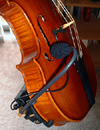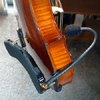Study:
I began studying violin at around age 6 using the Suzuki method, and continued until age 16, by which time I had become involved in other hobbies to the point where I just wasn't practicing anymore. I always intended the break to be temporary, but little did I realize that it would be another 15 years before I took lessons again. As I became interested in playing Celtic music, instead of just listening to it, I picked up the fiddle again, had it restrung and the sound-post replaced, and started messing around on some session tunes in the fall of 2000. Dissatisfied with my progress on fiddle, and as my piping began to show significant progress, I began to look for an instructor.
I found that teacher in Elke Baker, the 1995 U.S. Scottish Fiddle champion, who teaches from the Washington Conservatory of Music, in Bethesda, MD, and began studying with her in January 2002. Elke is a great instructor, and in addition to pushing me along with the fiddling, has been a great source of information for the concepts in Scottish music in general, something I've been able to carry over to my piping. Elke is also a specialist in 18th century Scottish music, and I plan on making full use of her knowledge as I delve into period performance. I've spent the last semester (fall '06) being introduced to backing, accompanying, and harmonies. In the previous semesters, we read through the Fraser and Skye collections (spring '06) and Marshall and Gow tunebooks (fall '05), the particulars of playing in the Scottish Country Dance style, and on to a study of repertoire strathspeys and slow airs (spring '05), and broadening my knowledge of repertoire reels, or rather, "the reels every Scottish fiddler should know" (fall '04).
Elke is also the music director for the Potomac Valley Scottish Fiddle Club, which meets once a month around the D.C. metro area, except in summer, where its members often perform, solo or as a group, at the various summer Celtic festivals and Highland games. I first joined for the 2002-2003 year, and have really enjoyed the meetings since. This year, I was more active than I have ever been in the club, attending six of the nine monthly meetings.
Equipment:
Oddly enough, fiddlers aren't as single-mindedly focussed on their equipment as pipers are. In fact, my Scottish fiddle teacher goes to great lengths to point out that one can get excellent tone from an expensive fiddle, inexpensive string, and so on. For her, the bow is key. I talk more about my bows below.
 |
 |
 |
 |
 |
 |
 |
 |
 My original instrument
is a E. R. Pfretzschner student violin made in Germany in 1970, which
was bought by my parents
from a former violin instructor around 1982. It's
taken a few knocks, nicks on the finish, and a corner broken off the upper
face, but I love this fiddle dearly. It's as old as I am, and it's been
with me for 20 years. When
I was first jamming with my friend Maggie Drennon, she commented that it
had a "harmonica-like quality", "like the fiddle in the PBS Civil War
series". The comparison is flattering, but
I don't know if it holds up under scrutiny. Compared to my new violin, the sound
is thin, and it doesn't ring particularly strongly. But it's a good solid instrument,
and I've equipped it with a pick-up (see below) for bar gigs and the like. I tend to keep
this instrument tuned to A = 440 Hz. The strings I'm currently using
are Pirastro Evah Pirazzi medium Violin Strings and so far I'm pretty
happy with them.
My original instrument
is a E. R. Pfretzschner student violin made in Germany in 1970, which
was bought by my parents
from a former violin instructor around 1982. It's
taken a few knocks, nicks on the finish, and a corner broken off the upper
face, but I love this fiddle dearly. It's as old as I am, and it's been
with me for 20 years. When
I was first jamming with my friend Maggie Drennon, she commented that it
had a "harmonica-like quality", "like the fiddle in the PBS Civil War
series". The comparison is flattering, but
I don't know if it holds up under scrutiny. Compared to my new violin, the sound
is thin, and it doesn't ring particularly strongly. But it's a good solid instrument,
and I've equipped it with a pick-up (see below) for bar gigs and the like. I tend to keep
this instrument tuned to A = 440 Hz. The strings I'm currently using
are Pirastro Evah Pirazzi medium Violin Strings and so far I'm pretty
happy with them.I didn't use a shoulder rest for my first three years as a fiddler, not to make some "I'm a fiddler, not a violinist" mission statement, I just found it perfectly comfortable to play without, and it makes it easier to grab the instrument and start playing. This also will make my period performance with the Jacobite reenactment regiment I've joined much more comfortable. However, as I've begun to play more tunes that require vibrato and 3rd and higher positions (like Skinner's The Sadness of Life, I've begun to do as classical musicians did - hold the instrument like a violin instead of like a fiddle.
 |
 |
 |
 |
 |
 |
 |
 |
 |
When played, the kit is held against the chest, like the medieval violin, or vielle, and not under the chin. This makes it a bit of a challenge to play; the instrument tends to rotate in the hand, it's hard to access the low strings, and higher positions are out of the question. In addition, intonation is tricky, because of the smaller scale length. The finger spacing in 1st position is like playing in 3rd position on a full sized instrument. The kit is a fascinating and little known instrument nowadays, and is always a conversation starter when I take it out to play. I intend to use it mainly for historical demonstrations; but it also is great for travelling.
My alternate modern bow is a heavy brazil-wood bow from A. Lorenz (upper middle), which I bought a year before, in 2003. The weight is a bit different from the Coda bow, much closer to the frog, and the bow's flexibility is also different, but it's a good bow. I purchased both bows at the Brobst Violin Shop in Alexandria, VA.
For period performances I use one of two period bows (bottom two) made in 2004 by Walther Mahr in Germany, and purchased from Lark in the Morning. Note the distinct shape of the bows - they decend from earlier bows, which were really shaped like an archery bow. These bows are well-balanced, and made of brazil-wood with ebony frogs and fittings. Though a true period bow would be clipped into place, making the tension adjustable only when the bow is rehaired, these bows incorporate a discrete modern screw mechanism for tightening the bow. Some modern conveniences are too handy to give up, even on a reproduction period bow!
 The
The  pick-up
I'm using on the Mahr violin is the Fishman Concertmaster system. It consists of a piezo-electric bridge pickup,
combined with a condenser microphone on a gooseneck. The electronics, pre-amp, and balance and
volume controls are built into a shoulder rest. This is a very versatile amplification system - it
allows me to put all piezo in the monitors, reducing feedback, and a balanced mix of piezo and
condenser into the mains for the best sound. Unfortunately, the piezo that came with the system
was designed to fit in the slot in a modern bridge, and thus did not work with a baroque violin. I
corrected this by replacing it with a Barcus Berry 3100 clamp-on piezoelectric violin bridge pickup. I simply swapped
connectors between the Fishman and Barcus Berry piezos, and I was ready to go. All in all, it's a
great combination, and can be installed or removed almost as easily as installing or
removing a shoulder rest.
pick-up
I'm using on the Mahr violin is the Fishman Concertmaster system. It consists of a piezo-electric bridge pickup,
combined with a condenser microphone on a gooseneck. The electronics, pre-amp, and balance and
volume controls are built into a shoulder rest. This is a very versatile amplification system - it
allows me to put all piezo in the monitors, reducing feedback, and a balanced mix of piezo and
condenser into the mains for the best sound. Unfortunately, the piezo that came with the system
was designed to fit in the slot in a modern bridge, and thus did not work with a baroque violin. I
corrected this by replacing it with a Barcus Berry 3100 clamp-on piezoelectric violin bridge pickup. I simply swapped
connectors between the Fishman and Barcus Berry piezos, and I was ready to go. All in all, it's a
great combination, and can be installed or removed almost as easily as installing or
removing a shoulder rest.
The pick-up I'm using on the Pfretzschner violin is the V-02 Std. Pickup system from Schatten. It's a single piezo element built into the bridge, which does have to be shaped to fit the player's preferred height and thickness (I used a Dremel tool grinding wheel and my old bridge as a template). I've been very happy with it so far; it's designed to sound good without a preamp.
I also received a violin kit from Grizzly Industrial, Inc. as a 33rd birthday present from my father. I'm taking my sweet time building it, but as I go further with it I'll post pictures of its construction and assembly here.
Irish Fiddling: